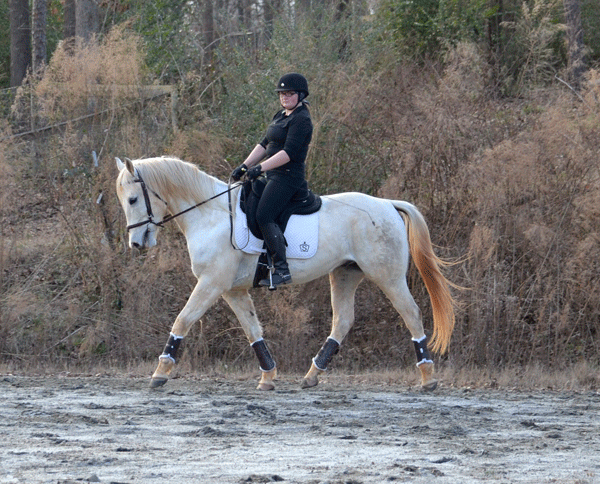This photo shows Mickensey Giraulo Johnson riding Regalo, a 6-year-old Lipizzan–Dutch Warmblood–cross. They are schooling First and Second Level at home.
In this photo, Regalo is in a working trot. To improve his movement he could shift a little more weight to his hind legs; lowering his croup would allow him to lengthen his neck and bring his nose further in front of the vertical.

When measuring the distance between the two hind legs and the two front legs, one can notice that Regalo appears to take a little longer step with his hind legs and a shorter step with his front legs. This is a sign that his balance pushes his center of gravity in the direction of his shoulders—forcing his front legs to land faster and not allowing more ground coverage. This can often be seen in photographs of horses that are moving a little slow in the hind legs. When they become quicker in the engine, the hind legs step more active, giving the front legs more time to lengthen in the stride.
This tiny balance issue between the front and back of the horse is counterbalanced by the rider. Mickensey is sitting with her upper body very slightly leaning backward. She surely wants to sit deep, but with her weight pushing forward, the direction of her influence is more towards the front legs.This way, her weight is pushing the horse’s shoulders and front legs to land quicker and this can cause the shorter steps of his front legs with not enough freedom for his shoulder to move. Even though I only see this as a photograph, my advice for Mickensey would be to work more on the rhythm in her riding.
Quick does not mean fast! And schooling Second Level is asking for the beginning of collection, where the horse needs to learn to lower the croup and take more weight on the hind legs. But quicker steps give the horse more stability for his balance and strengthen his back. To understand this, stand balanced on both feet and swing your relaxed arms next to your body. Increasing the speed of the arms next to one’s body will automatically increase the basic muscle tone and tension within the whole body.
That means if the horse swings his hind legs quicker under the rider’s weight, he will have better stability within his body.
Riding small transitions will help to influence the speed of the horse’s hind legs. This is an important tool for the rider’s ability to train a horse.
Try this: Use a metronome to find your horse’s basic tempo in trot so you can try to speed up the tempo just one or two beats per minute and then stick with this tempo when working on changes of pace within the trot. This does not have to be medium trot to collected trot, just a little difference in the strides while maintaining the same tempo.
Try this: Riding on a circle while adjusting the stride can help to maintain a better balance for the horse. A great tool to teach the feel for the correct tempo can be counting the horse’s steps on a quarter of a circle and, after managing to keep this steady, deliberately increasing the number of steps per quarter. This clearly shows that shorter the strides requires more steps over the same distance. Merely slowing down will not change the ground coverage of the horse.
Being challenged to look for the next quarter will help the rider to look forward and plan the next step. Often riders automatically rebalance their upper-body position and sit a little further forward in this task. Mickensey should imagine that she can sit a little lighter with a quicker rhythm to enable Regalo to lift the back up and become quicker in his engine.
Mickensey needs to remember that the center of her forward-driving aids in her upper body is more in her tummy than in her shoulders. Keeping her shoulders more forward and over her pelvis will help to activate her abdominal muscles and give her a better balance to use her seat quicker.
Susanne von Dietze is a leader in equestrian biomechanics. A physiotherapist, licensed Trainer A instructor and judge for dressage and show jumping, she gives lectures and seminars throughout the world, including at the prestigious German Riding Academy in Warendorf. She is a native of Germany and now lives with her husband and three children in Israel, where she competes at the international level. She is the author of two books on the biomechanics of riding: Balance in Movement and Rider and Horse, Back to Back. Find her books at HorseBooksEtc.com.











